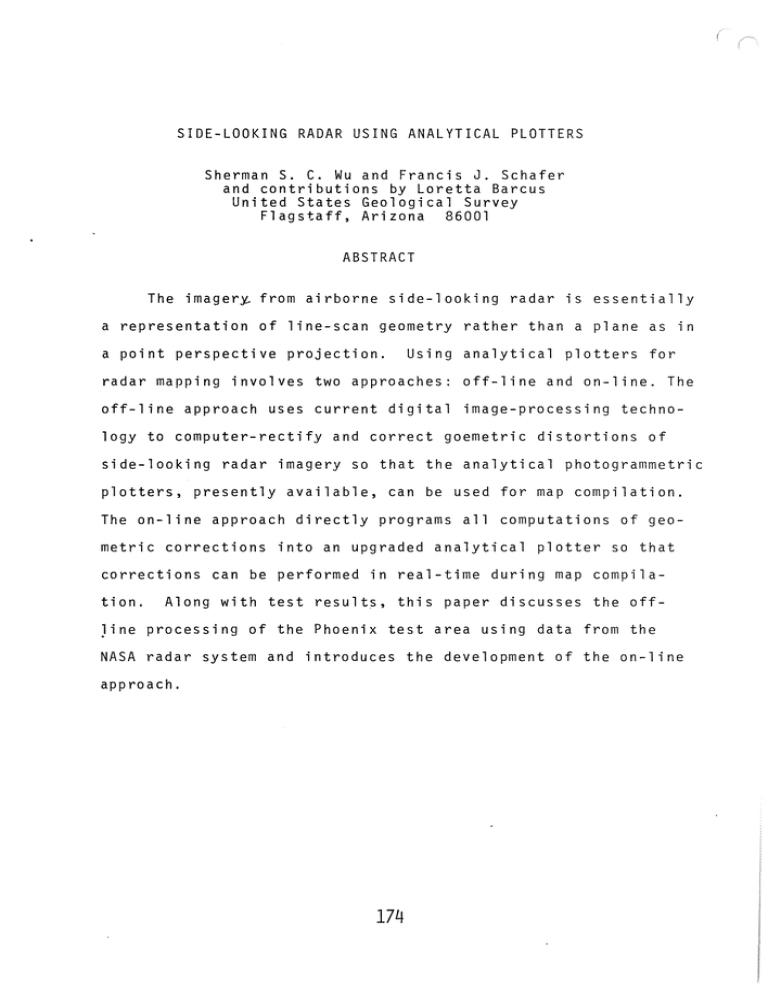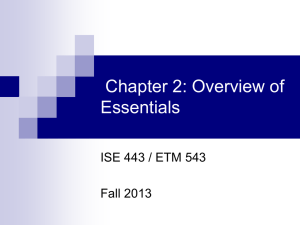SIDE-LOOKING RADAR USING ANALYTICAL PLOTTERS
advertisement

SIDE-LOOKING RADAR USING ANALYTICAL PLOTTERS Sherman S. C. Wu and Francis J. Schafer and contributions by Loretta Barcus United States Geological Survey Flagstaff, Arizona 86001 ABSTRACT The imager~ from airborne side-looking radar is essentially a representation of line-scan geometry rather than a plane as in a point perspective projection. Using analytical plotters for radar mapping involves two approaches: off-line and on-line. The off-line approach uses current digital image-processing technology to computer-rectify and correct goemetric distortions of side-looking radar imagery so that the analytical photogrammetric plotters, presently available, can be used for map compilation. The on-line approach directly programs all computations of geometric corrections into an upgraded analytical plotter so that corrections can be performed in real-time during map compilation. Along with test results, this paper discusses the off- Jine processing of the Phoenix test area using data from the NASA radar system and introduces the development of the on-line approach. 174 INTRODUCTION High resolution side-looking radar is really an invaluable 11 all weather 11 mapping tool. It is perhaps the only reasonable way that mapping can be performed for the areas of the Earth which are almost always covered by clouds and for mapping the Planet Venus which is entirely covered by clouds. Because of this, map compilation using stereo radar imagery is very desirable and has previously attempted. Due to the uniqueness of radar geometry, which is essentially effected by its method of illumination and image formation, stereo radar imagery has not been thoroughly analyzed in the past to any great extent (Leberl, 1977), and topographic contour maps cannot be directly compiled on conventional stereo photogrammetric equipment. Research to solve the problems inherent in extracting topographic information from radar imagery using analytical plotters is approached in two phases (Wu, 1979). Phase 1 is to apply current technology of digital image processing to computer rectify the radar imagery so that the present available analytical plotters can be used for map compilation. Phase 2 is to interface a high-speed digital computer to an analytical plotter for enhancing the programming flexibility so that all computations of geometric rectification and corrections can be performed in real-time during the processing of model orientation and map compilation. Research tests in the Phase 1 approach include off-line computerzied rectification of stereo side-looking radar images for compilation on the AP/C analytical plotter. The images are of Huntsville, AL, Pinedale, WY, and Phoenix, AZ. using different radar systems. All were acquired Development in fue Phase 2 approach 175 includes the use of an upgraded AS-llA analytical plotter and the interface of a Modcomp computer to the only existing radar stereoplotter developed by the Goodyear Aerospace Corporation for the Army Engineering Topographic Laboratory. METHOD AND TEST RESULTS Radar imagery constructed by a radar correlator processor represents a line-scan geometry. In order to use the AP/C analy- tical plotter, the radar imagery is first digitized by an Optronics device. By applying computer digital image-processing tech- niques, the digital data is then rectified from the line-scan geometry to an equivalent of a point-perspective frame picture. The rectification is performed using a gnomonic projection. The rectification can be performed pixel by pixel using a general purpose computer with magnetic tape output to an Optronics Photowrite. The Optronics writes the image on photosensitive film. A pair of radar imagery of the Huntsville area taken by a UPD-4 radar system was tested for computer rectification. The original photo scale is 1:100,000 with a ground resolution of 10 feet. A stereo model was established on the AP/C analytical plot- ter using pre-computed model parameters. But due to the fact that this pair of radar imagery was taken from the same side the baseto-height ratio is so small that photogrammetruc compilations and measurements could not be performed. A second attempt was to rectify a pair of stereo radar imagery of a glacial lake of Pinedale, Wyoming, looking from the same side but using different modes of the NASA radar system. Different modes have different depression angles (the depression angle of mode 1 is 57° and mode 2 is 35°). 176 This makes the base-to-height ratio larger so that it is then possible to compile a contour map from the model on the AP/C analytical plotter. However, due to the fact that very severe distortions occurred in the model 1 imagery from an unknown error source in the radar system, the map compiled from the model has large errors when compared with a standard U. S. Geological Survey 1:62,500 topographic map. Because the mode a third test was made. of the NASA radar system has system errors, In this test a pair of stereo radar, mode 2, imagery was rectified. This imagery cover Phoenix (Arizona) area and was taken by the Defense Mapping Agency. This pair of radar imagery was taken from opposite side and therefore has very strong geometry. A stereo model was set up on the AP/C analytical plotter and photogrammetric measurements were made along with a map compilation. The radar imagery was taken at an altitude of 60,000 feet and has a scale of 1:200,000. about 50 feet. is 1:800,000. The resolution of the radar system is However, the scale of the rectified photographs The map was compiled at a scale of 1:250,000 so that a comparison can be made with the U. S. Geological Survey 1:250,000 topographic map. But due to the fact that the covered area between Phoenix and the White Tank Mountains, is very flat, the planimetry was compiled from the model. Ground coordinates and elevations of about 150 discrete points were also measured. The planimetry compiled from the rectified radar model on the AP/C analytical plotter matches the U. S. Geological Survey topographic map fairly well. Eighty-eight elevations measured from the model were compared with the U. S. Geological Survey l :250,000 topographic map, about one third of the elevation differences are less than 5 177 meters, 50% of the elevation differences are less than 10 meters, 68% less than 20 meters, 86% less than 30 meters and 92% less than 40 meters. However, when the horizontal coordinates read out from the model are compared with those measured from the map, about 60% of the horizontal displacements are less than 250 meters and 90% less than 400 meters, which are 0.3 and 0.5 millimeters at the photo scale. The phase 2 approach is to use a Modcomp computer which is interfaced to an AS-llA analytical plotter. Since the Modcomp computer is Fortran programmable, all rectification and geometric distortion corrections can be programmed be performed in real-time. memory. in~o the plotter and will The Modcomp computer has a 64k core Peripherals include 2 magnetic tape drives, 3 disks, a card reader and DEC terminal. interfaced. All computer components have been The software modification is currently in progress. In parallel with the development of the modification of the AS-llA analytical plotter, the phase 2 approach also includes interfacing of the Modcomp computer to the existing radar stereo plotter which is currently in progress. DISCUSSION In either the on-line or the off-line approach, the capability of the analytical plotter system is essential to the development of the stereo mapping problem using side-looking radar imagery. With computer rectification in the off-line processing, an oridinary analytical plotter can be used for mapping using radar imagery. The accuracy of the products is not yet adequate for standard mapping. However, through long range research the analytical plotter 178 system may be developed for stereo mapping with side-looking radar imagery. REFERENCES Leberl, Franz, 1977, Stereoradar Interoffice Memorandum to Chales Elachi, Aug. 28, 1977, 16 p. Wu, Sherman S. C., 1979, Radar Photogrammetry, Report of Planetary Geology Program, NASA Technical Memorandum 80339, June 1979, pp. 426-428. 179








